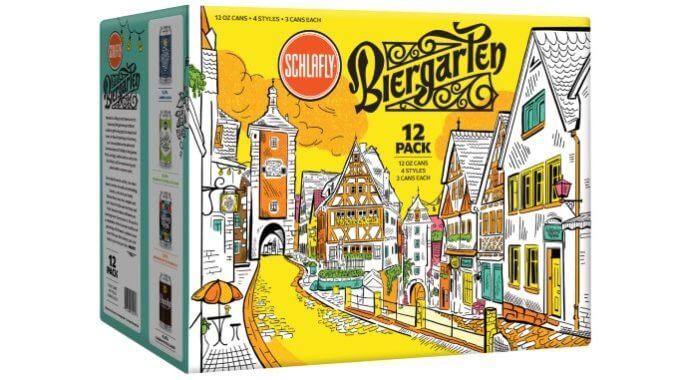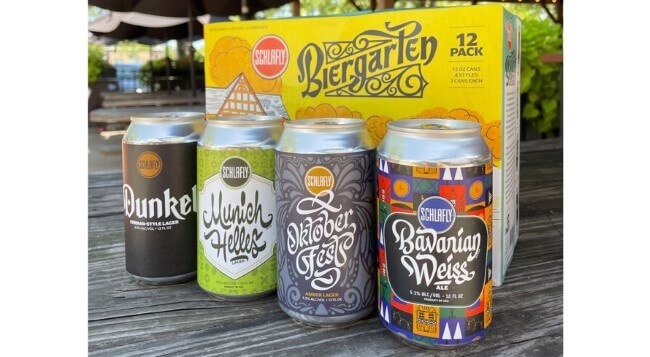Tasting: 4 Classic German Brews from the Schlafly Biergarten Variety Pack

Regardless of whatever else might be in the craft beer zeitgeist in any given moment–which, to be fair, has been pretty stagnant in recent years–the popularity of the beer variety pack has never really waned. Which makes perfect sense, if you ask us–they’ve always been a convenient, high-value way for new drinkers in particular to sample a wider array of beers from a single brewery. If there’s one thing that’s been true of all too many variety packs in recent years, though, it’s the following: They’ve typically been completely inundated with India pale ale. As IPA has continued to gobble up an ever-increasing share of the beer pie, variety packs have often reflected their cultural dominance. Many breweries, in fact, regularly put out “variety” packs that are just samplers of various IPA brands, and good luck trying to find one that doesn’t at least contain a company’s flagship IPA, whether or not you really want to buy that brand. For those of us who have yearned for more variety beyond the world of American IPA, it has made variety packs somewhat less useful than they were in the distant past. That’s what makes the Schlafly Biergarten variety pack so refreshing, in both the literal and figurative sense.
Simply put, this is a canned autumn beer variety pack, entirely focused on classic German beer styles from the Saint Louis Brewery, better known simply by its brand name of Schlafly. It’s a rare instance of a brewery resisting the urge to include at least one hop-forward American style in a variety pack, and that’s such an attractive proposition to me in this day and age–where IPA is everywhere, and always accessible–that I thought it deserved a shout out and tasting. You just don’t come across this sort of thing very often at this point–I certainly can’t think of any variety packs on the shelf in my neck of the woods, in Richmond, Virginia, that contain a Munich Helles, Dunkel, Weissbier and Marzen, without a hint of IPA in the proceedings.
It’s also a good reminder of Schlafly’s long history since 1991 with classic European beer styles, such as their flagship English Pale Ale, styles that have become increasingly difficult to sell to many IPA-focused consumers over the course of the last decade. Schlafly has persisted as a St. Louis icon, refusing to bow to what is probably considerable market pressure to abandon some of these older staple styles that are no longer seen as hype or sexy by many modern drinkers. For that, I also salute them.
“Schlafly’s Oktoberfest is such a huge hit with our customers for the fall season that we wanted to create a full pack that embodies German seasonal beers,” says Schlafly CEO, Fran Caradonna. “This is our take on classic recipes and a nod to the rich history of that particular tradition.”
So with that said, let’s dive into tasting all four beer styles in this Schlafly Biergarten variety pack.
Schlafly Munich Helles Lager
ABV: 4.5%
The modestly more balanced brother to German pilsner, helles lager is one of the world’s great, quaffable beer styles, displaying a balance of crisp grain, malt sweetness and moderate noble hoppiness. The dividing line here between helles and pils tends to be a fairly narrow one, as some American craft breweries will brew a helles with enough hoppiness that it’s more intensely hop-forward or bitter than another brewery’s pilsner, but as time has gone by it seems like both breweries and drinkers have a more nuanced view of this style. I find that seeing a helles on tap at an American craft brewery is often a very good sign, as it implies the brewery thinks their customer base will appreciate the subtleties of the style and recognize the small differences between it and pilsner.
Schlafly’s Munich Helles brings a slightly grassy aromatic, with crisp grain and ever-so-slightly bready notes. On the palate, it displays some nice floral and grassy hops, with some minerality that I often find myself associating with the style. Lightly malty sweet, it’s an excellent daily drinker and versatile beer for all sorts of meals.

Schlafly Dunkel Lager
ABV: 4.5%
Any day that a craft brewery near me decides to brew a traditional dunkel is always a day I’m thankful for. This has become one of my favorite beer styles in the last five years or so, traditionally finding some delicious middle ground between more intensely roasty dark lager styles like schwarzbier or Czech dark lager, and the greater malty sweetness of something like bock. In some ways, dunkel almost has more in common to the American palate with the likes of brown ale, albeit in lager form.
Schlafly’s Dunkel Lager smells just right–a classic example with a nose that suggests black bread, very darkly toasted bread crust, roasted nuts and slight dried fruitiness, with perhaps just the slightest wisp of smoke. Faint noble hops are found on the nose and palate, with the palate displaying nuts and bread crust, toasted malty sweetness, and faint dried fruit suggesting raisin. It’s the beer equivalent of multigrain toast, and I love it. Of all the beers in this Schlafly Biergarten variety pack, this one feels the most undeniably to style.
Schlafly Oktoberfest Amber Lager
ABV: 5.5%
This is definitely an older beer brand, a seasonal that presumably dates back to Schlafly’s earliest days, and a brand they produce every single year. The American palate has been trained on the idea of “Oktoberfest lager” for a long time, and it was beers like this one from Schlafly that helped establish those conceptions back in the 1980s, 1990s and 2000s.
Schlafly refers to this one as a Märzen, which is no surprise–it’s definitely not anything like the modern, lighter, more hop-forward and crisp festbier style. This has much more in common with the Oktoberfest lagers of yore, both abroad and in the U.S., when drinkers often expected to find beers bearing the word “Oktoberfest” to have big, expressive malt flavors and no shortage of caramel sweetness. This one is quite toasty on the nose, with assertive malty sweetness and slightly musty grain tones, into significant caramel and bread crust on the palate. Over the years, my own palate has often drifted in the direction of the crisper festbier style, but this is certainly a solid reminder of why so many people still think of Märzen as the quintessential fall beer style.
Schlafly Bavarian Weiss Ale
ABV: 5.1%
This is something of a curious offering for the Schlafly Biergarten variety pack, considering that the brewery already brews a year-round wheat beer that it has always called Schlafly Hefeweizen. Despite the name, though, this “hefeweizen” is really less of a German-style wheat ale and something more akin to American pale wheat ale, leaving a space open for this Bavarian Weiss Ale to be more of a traditional hefeweizen. These terms are all sort of confusing to begin with, given that some breweries seem to view “weiss” or “weizenbier” as a separate style from hefe. In the end, they all come from the German Weißbier (literally “white beer”), which was so named not because it was similar to Belgian witbier but because the pale, air-dried malt made the beer “white” in comparison with the darker brown beers of the day.
Schlafly’s Bavarian Weiss Ale is fairly mild on the nose, not having more bombastic German yeast character and instead favoring mild wheat malt sweetness and bready tones. There is a doughy yeastiness to it, but little of the classical “banana and clove” so often referenced in hefeweizens. These flavors show up a bit more prominently on the palate, where they’re joined by a mild orange citrus, doughy malt, biscuit and light floral tones. All in all, this is a quite tasty and easygoing wheat ale, which to me still seems to strike something of a bargain between traditional German and American styles.
Regardless, it was a real treat to go through an entire regional craft brewery variety pack and at no point have to nail down what kind of “juice” a hazy IPA was trying to evoke. I’ll be looking forward to revisiting all of these on my own patio for as long as the autumn may last.
Jim Vorel is a Paste staff writer and resident beer and liquor geek. You can follow him on Twitter for more drink writing.







































